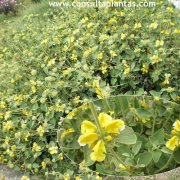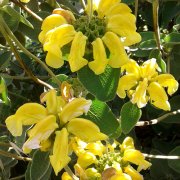Care of the shrub Phlomis chrysophylla or Golden-leaved Jerusalem sage |
|
The genus Phlomis, family Lamiaceae, comprises 100 species of shrubs and herbaceous plants native to Asia and the Mediterranean region. Some species are: Phlomis chrysophylla, Phlomis purpurea, Phlomis fruticosa, Phlomis italica, Phlomis russeliana, Phlomis lycia, Phlomis samia, Phlomis lanata, Phlomis lychnitis, Phlomis maroccana, Phlomis cypria, Phlomis viscosa. Common name: Golden-leaved Jerusalem sage. This species is native to the Mediterranean region and Central Asia. They are compact shrubs (woody at the base) that reach 1 meter (3.28 feet) in height and width. The foliage consists of larger basal leaves and leaves similar to those of Salvia officinalis located in the upper part of the plant; both types of leaves have a velvety texture. The flowers are yellow and appear in axillary groups. They bloom during the spring. Golden-leaved Jerusalem sage is used in rockery, on dry and sunny slopes, in low-maintenance gardens and in bushy groups. Phlomis chrysophylla prefers full sun exposure and a warm climate (Mediterranean climate). It resists occasional frosts. Golden-leaved Jerusalem sage grows in any well-drained soil: rocky, alkaline, poor, or sandy. Phlomis chrysophylla is a plant of easy cultivation and great resistance to drought. It only requires occasional watering in summer. Golden-leaved Jerusalem sage does not need fertilizers. Phlomis chrysophylla can be pruned after flowering to maintain a compact appearance. Golden-leaved Jerusalem sage is a quite resistant plant to pests and diseases. Phlomis chrysophylla is propagated by seeds sown in spring in a seedbed with a slightly damp sandy substrate. |
Images of the shrub Phlomis chrysophylla or Golden-leaved Jerusalem sage |
Find plants
Phlomis chrysophylla or Golden-leaved Jerusalem sage | Care and Growing
© 2026 FavThemes


